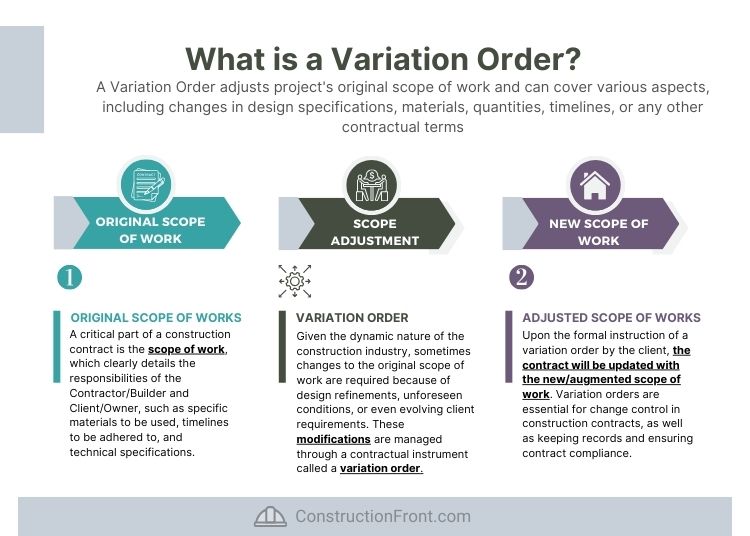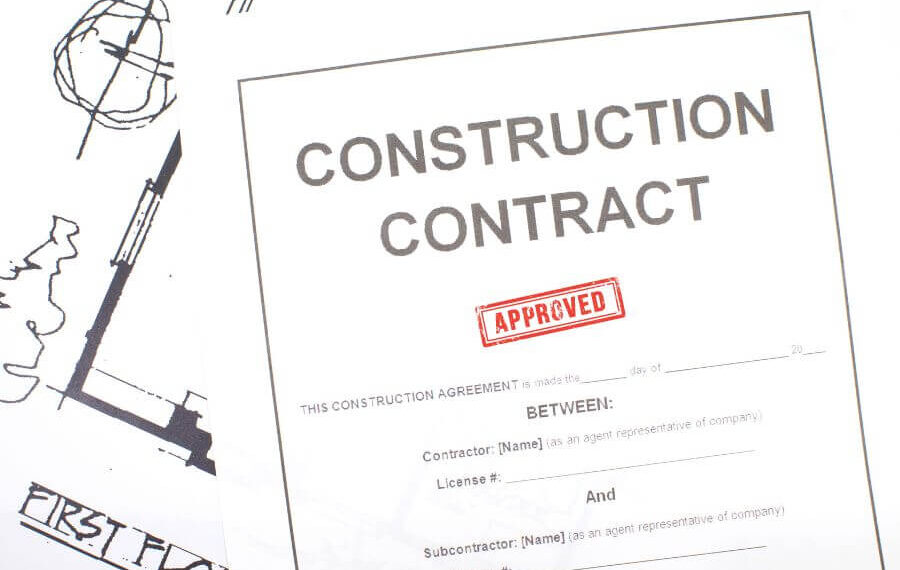

Construction projects are known for their dynamic nature, and changes, unfortunately, are common on both large and small-scale contracts. These changes can arise due to various factors, such as design refinements, unforeseen conditions, or even evolving client requirements. These modifications are usually managed through a contractual instrument called a variation order.
A Variation Order is an official document that outlines modifications or adjustments to a project’s original scope of work. Variation orders can cover various aspects, including changes in design specifications, materials, quantities, timelines, or any other contractual terms.
In this article, we further discuss this topic and understand what causes them, the risks associated with variation orders, ways to avoid and manage them, and provide a variation order template for your reference – Let’s dive in!
A variation order in a construction contract refers to a formal written instruction issued by the client or the project owner to make changes to the original scope of work. They are important for the following reasons:

Various factors can trigger variation orders in construction contracts, such as design update, unforeseen conditions, change of requirements by the owner, scope expansion or reduction, and project’s program updates.
The table below summarises some common causes that lead to agreement amendments, a brief description, and the respective example.
Cause
Description
Example
Design Changes
Modifications to the original design or specifications.
Revising the architectural plans due to aesthetic preferences or changes in functional requirements.
Unforeseen Conditions
Discovering unforeseen challenges or site conditions during construction.
Encountering unexpected soil instability that requires additional foundation work.
Client Requirement Changes
Alterations requested by the client due to evolving needs or preferences.
Requesting a different color scheme for the interior finishes or changing the layout of a room.
Scope Expansion
Adding additional work beyond the original contract scope.
Including an extra building wing or constructing an additional floor in an existing structure.
Schedule Adjustments
Modifications to the project timeline or sequencing of activities.
Accelerating the completion date to meet an earlier project delivery deadline.
Material Substitutions
Replacing specified materials with alternatives.
Substituting one type of flooring material with another that offers better durability or aesthetics.
Author’s Note: We note there are other several issues that can lead to change orders in construction agreements, such as changes in regulations or law, site access issues, weather conditions, and value engineering.
Construction projects are inherently dynamic, and changes during their execution are inevitable. Albeit sometimes required and beneficial for the final desired product, variation orders might create significant and unexpected risks to your project, such as:

As detailed above, variation orders can introduce complexities and potential risks to construction projects. So, how to avoid them? Use the following measures:
Mitigation Measure
Desired Outcome
How to Implement?
Thorough Project Planning
Minimize unexpected changes and variations
Conduct comprehensive project planning, including development of detailed design, site condition investigations, accurate cost estimation, and thorough risk assessment.
Clear and Comprehensive Contracts
Reduce ambiguity and provide a solid foundation for project execution, with clear scope delineation
Ensure contracts clearly define the scope of work, specifications, timelines, and change management procedures. A matrix of responsibilities might be helpful.
Effective Communication
Identify potential issues early and facilitate prompt resolution
Foster open and transparent communication among all project participants, including clients, contractors, and subcontractors.
Detailed Documentation
Establish a clear audit trail and proper management of variations
Maintain meticulous documentation throughout the project lifecycle, including meeting minutes, change orders, and relevant correspondence.
Regular Project Monitoring
Identify emerging issues and intervene timely
Implement a robust project monitoring system (such as early warning notices – click here to read our article on it), including regular site inspections and progress meetings, to track progress and identify potential issues that might lead to variations.
Collaborative Problem-Solving
Address potential issues before they escalate into variations
Encourage collaboration and proactive problem-solving among project stakeholders through regular meetings and open dialogue.
Change Management Procedures
Properly assess and manage variations in a controlled manner
Establish a well-defined change management process that includes evaluation, impact assessment, and approval protocols for proposed changes.
Proactively address potential risks to minimize variations arising from unforeseen circumstances
Implement a robust risk management framework, including identifying, assessing, and mitigating risks throughout the project lifecycle.
Author’s Note: Another key aspect of mitigating alterations and amendments in your construction contract is ensuring that the implemented agreement model is adequate.
Each contracting approach (Construction Only, Alliance Contracting , D&C, EPC , etc.) comes with a different risk profile, and you should consider what is the most suitable for the project’s characteristics. If you need some advice, please do not hesitate to contact us (click here)
The template below is generic and very simple, and should be used as a reference only. We strongly recommend taking some specific advice to ensure your rights are reserved and protected.
We offer specialised commercial and contractual advice, and do not hesitate to contact us.
VARIATION ORDER #22
Subject: Variation Order #22 – Additional Excavation Around Piles
The Owner refers to the agreement executed on [date] between the Owner and the Contractor for the Construction of a Warehouse.
Pursuant to clause 10.3, the Owner hereby instructs the Contractor to proceed with the following Variation Order.
The Contractor is directed to undertake additional excavation around piles 1, 2 and 3 as per instructions attached to this notice (include attachment)
The costs associated with this Variation Order are $1,000.00
The Owner understands there are no time impacts associated with this Variation Order.
Should the Contractor have any concerns or queries regarding this Variation Order, please do not hesitate to contact us immediately to discuss and clarify.